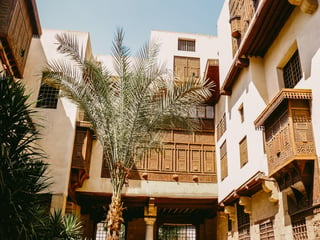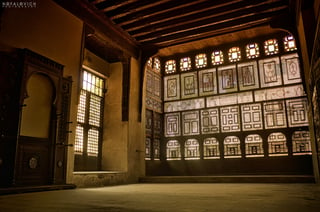Bayt Al-Suhaymi, a 17th-century historic residence in Cairo, is a testament to the city's rich heritage. Its Ottoman-inspired design, once the home of a prominent scholar, holds cultural significance and captivating stories that invite visitors to experience a bygone era, making it a symbol of Cairo's enduring legacy. To explore Egypt, you must obtain an Egyptian visa before your trip. This essential document allows you to visit and enjoy the beautiful attractions and rich history of this fascinating country.

Exploring Bayt Al-Suhaymi: Unveiling the Tale of an Ancient House
Step into the fascinating history of Bayt Al-Suhaymi, an ancient house that transports us to a bygone era of tranquillity and cultural richness. For those with a passion for uncovering the heritage and history of different countries, this journey is an invitation to delve into the captivating narrative of this extraordinary historic residence.
- The Origins of Bayt Al-Suhaymi: A Glimpse into the Past
The story commences in the year 1648 A.D Nearly four centuries in the past, when the Sheik embarked on the ambitious endeavour of acquiring land in Cairo's Gamaleya neighbourhood to build his own abode. This splendid house gracefully stands in al-Darb al-Asfar Lane, al-Gamaliyya, along the illustrious al-Muizz Street.
Al-Tablawi's architectural choices took inspiration from the Ottoman style, resulting in a layout quite distinct from traditional Egyptian homes.
Notably, the house was divided into two distinct sections: "Al-Salamlek," designated for men on one floor, and "Al-Haramlek," reserved for women on the upper floor.
- The Evolution of Bayt Al-Suhaymi: A Tale of Two Sections
Remarkably, Sheikh Al-Tablawi did not bequeath the house to his descendants. Instead, some decades later, Haj Ismail ibn Ismail Shalaby assumed ownership, introducing a new section to the house and seamlessly amalgamating it with the original structure.


The Mystery of the Name: Why "House of Al-Suhaymi"?
The "House of Al-Suhaymi," initially built by Sheikh Al-Tablawi, bears an enigmatic name not linked to its first builder but to its last residents. In 1813 A.D, The house was acquired by Sheikh Shihab al-Din Ahmad Al-Suhaymi, a renowned scholar of al-Azhar and the sheikh of the Turks' gallery during the Ottoman era.
His family occupied the house for over a century, maintaining their connection to it until 1931 when the heirs of the Al-Suhaymi family sold it to the Committee for the Preservation of Arab Antiquities, cementing its contemporary identity as the "House of Suhaymi."
- A Glimpse Inside Bayt Al-Suhaymi
Bayt Al-Suhaymi is a complex of interconnected buildings surrounding a picturesque central courtyard. Its exterior features intricate wooden mashrabiyas, while inside, there's a grand Maqad balcony and a tastefully furnished reception hall, showcasing the opulence of its era.
Historical artefacts include a birthing chair, a bathroom, operational wells, a waterwheel, and a mill powered by a bull, highlighting its self-sufficiency. Pottery and stone vessels for storing grains reflect its role as a bustling hub of daily life and activity in the past.
A Hub of Artistic Creativity: The Transformation of Bayt Al-Suhaymi
The transformation of Bayt Al-Suhaymi into a hub of artistic creativity on Cairo's Al-Moez Street showcases Egypt's commitment to preserving its cultural heritage. Supported by the Arab Fund for Economic Development in 1996, meticulous restoration preserved its rich history,

- A New Life for Bayt Al-Suhaymi
In 1996, Egypt embarked on a visionary restoration project for Bayt Al-Suhaymi, funded by the Arab Fund for Economic Development. This multimillion-pound initiative encompassed documentation, meticulous restoration, and enhancements.
After restoration, the house was repurposed into a centre for artistic creativity under the Cultural Development Fund while retaining its historic name, the "House of Al-Suhaymi." This transformation preserved its rich history and ensured its continued relevance as a dynamic hub for cultural and artistic expression.
FAQS
What is Bayt Al-Suhaymi, and where is it located?
Bayt Al-Suhaymi is an ancient house located in the Gamaleya neighbourhood of Cairo, Egypt. It stands on al-Darb al-Asfar Lane, along al-Muizz Street, and is renowned for its unique architecture and historical significance.
Who originally built Bayt Al-Suhaymi, and when was it constructed?
Bayt Al-Suhaymi was initially built by Sheikh Abd Al-Wahhab El-Tablawi in the year 1648 A.D. This historic residence has a history dating back nearly four centuries.
How is Bayt Al-Suhaymi's architecture unique?
Bayt Al-Suhaymi's architectural design was influenced by Ottoman architecture. It consists of two main sections: "Al-Salamlek" for men on one floor and "Al-Haramlek" for women on the upper floor, which was an unconventional layout for traditional Egyptian homes of that era.
Why is it called the "House of Al-Suhaymi"?
The house is named after Sheikh Shihab al-Din Ahmad Al-Suhaymi, who acquired the house in 1813 He was a prominent scholar of al-Azhar and the sheikh of the Turks' gallery during the Ottoman era. His family lived in the house for over a century, leading to the adoption of the name "House of Al-Suhaymi."
What are some notable features of Bayt Al-Suhaymi's interior?
Inside Bayt Al-Suhaymi, you can find a picturesque courtyard surrounded by several buildings. The house boasts beautiful wooden mashrabiyas (lattice windows), a spacious Ma'ad (seated balcony), and a furnished reception hall. Unique elements include a birthing chair, a bathroom, water wells, a waterwheel for irrigation, and a bull-operated mill.
How did Bayt Al-Suhaymi become a centre for artistic creativity?
The government initiated a restoration project for Bayt Al-Suhaymi with funding from the Arab Fund for Economic Development. After five years of restoration, the house was repurposed into a centre for artistic creativity, affiliated with the Cultural Development Fund. It now serves as a hub for hosting folklore groups and promoting cultural and artistic activities.
Is Bayt Al-Suhaymi open to the public for visits?
Yes, Bayt Al-Suhaymi is open to the public, allowing visitors to explore its rich history, architecture, and cultural significance. It provides a unique opportunity to step back in time and experience Cairo's heritage.
Like
Dislike
To obtain a Egypt eVisa
- Step1: Complete the online application by providing your passport details.
- Step2: Submit payment online using a credit card.
- Step3: Monitor your email for confirmation of payment and receipt of your eVisa, which will be sent electronically.

Comment